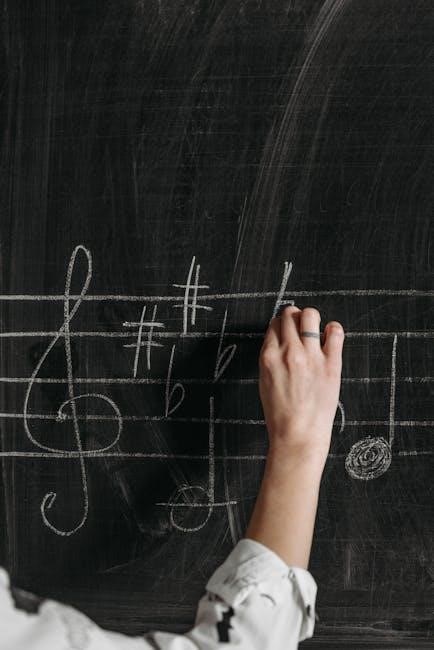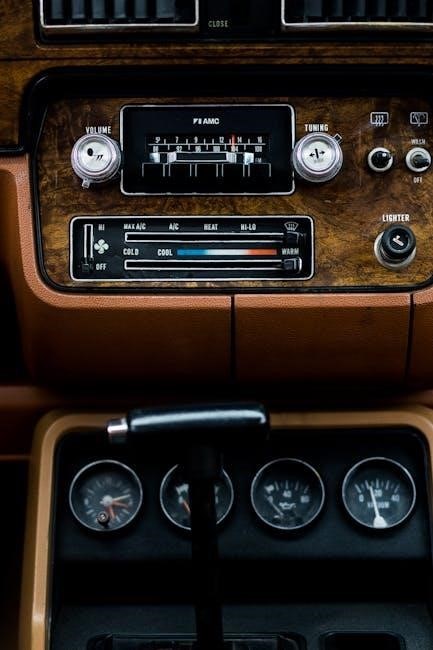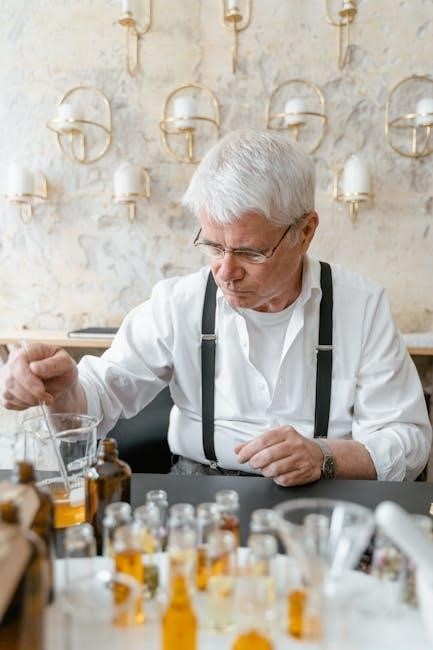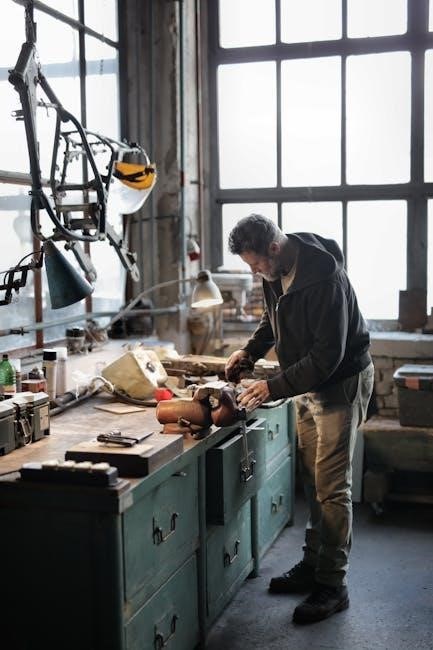The Black & Decker Even Steam Iron is a versatile household appliance designed to tackle various fabrics with ease. It features an easy-fill water tank and even steam distribution for optimal wrinkle removal. The manual provides instructions for safe and efficient use, covering models like IR12XS and IR16X. Discover how to achieve professional results with this trusted steam iron.
Key Features of the Black & Decker Even Steam Iron
The Black & Decker Even Steam Iron offers a range of features designed for efficient and effective ironing. One standout feature is its even steam distribution, which ensures consistent moisture across the entire ironing surface, helping to eliminate wrinkles effortlessly. The temperature settings are adjustable, allowing users to select the perfect heat level for different fabrics, from delicate silk to sturdy cotton.
Another key feature is the easy-fill water tank, which。,。Moreover, the iron can be used as a dry iron even when the water tank is empty, making it versatile for various tasks.
For added convenience, the manual provides detailed instructions on fabric care, including recommended temperature and steam settings for different materials. Safety features, such as automatic shut-off, also enhance user protection and peace of mind while ironing. With these features, the Black & Decker Even Steam Iron stands out as a reliable and user-friendly appliance for everyday use.
Understanding the Black & Decker Even Steam Iron Manual
The Black & Decker Even Steam Iron manual is your guide to mastering the use and care of this versatile appliance. It provides detailed instructions on setting up, operating, and maintaining your iron for optimal performance. The manual includes sections on how to adjust temperature settings for different fabrics, ensuring your ironing meets the needs of your garments.
One of the key sections in the manual is the fabric care chart, which offers recommendations for temperature and steam settings for various materials. This helps users avoid damaging delicate fabrics while effectively removing wrinkles from sturdy textiles. Additionally, the manual explains how to use the iron as a dry iron, providing flexibility for users who prefer or need to iron without steam.
Safety is a priority, and the manual emphasizes proper storage and usage guidelines to prevent accidents. It also highlights authorized repair procedures, directing users to contact Black & Decker for professional assistance when needed. By following the instructions in the manual, users can extend the life of their iron and maintain its performance over time. This comprehensive guide ensures that every feature of the Black & Decker Even Steam Iron is utilized to its fullest potential.
Downloading the Black & Decker Even Steam Iron Manual
Downloading the Black & Decker Even Steam Iron manual is a straightforward process that allows users to access essential information about the appliance’s features, settings, and maintenance. Visit the official Black & Decker website or contact customer support to obtain the manual in PDF format. The manual is available for popular models like the IR18XS and IR12XS, ensuring compatibility and relevance.
Once downloaded, the manual provides detailed instructions on how to set up and operate the iron, including temperature adjustments and steam settings for different fabrics. It also includes safety guidelines, care tips, and troubleshooting advice to ensure optimal performance. The document is typically a small file, around 252KB, making it easy to download and store for future reference.
Users can also find the manual on third-party sites, but it is recommended to download directly from the manufacturer to ensure authenticity and up-to-date information. If you encounter difficulties accessing the manual, contact Black & Decker customer service for assistance. Keeping the manual handy is crucial for leveraging the full potential of your Even Steam Iron and maintaining it properly for long-lasting use.

Models Covered in the Manual
The Black & Decker Even Steam Iron manual covers a range of models, including the IR12XS, IR16X, and IR18XS; These models are designed to provide versatile performance for various fabrics, ensuring smooth and effective ironing. Each model is equipped with advanced features, such as even steam distribution and adjustable temperature settings, to meet different household needs.
The manual also includes specific instructions for One Step Steam Iron models, ensuring users can operate these appliances efficiently. Whether you need to tackle delicate fabrics or heavy-duty materials, the manual offers tailored guidance for each model mentioned. This ensures that every user can achieve professional-level results, regardless of their experience level. By referencing the manual, users can fully understand the capabilities and care requirements of their specific Black & Decker Even Steam Iron model.
Getting Started with Your Iron
Before using your Black & Decker Even Steam Iron, familiarize yourself with the controls and features outlined in the manual. Start by filling the easy-fill water tank, ensuring it is properly locked in place for safe operation. Select the appropriate temperature setting based on the fabric you intend to iron, referring to the fabric care chart for guidance. Always ensure the iron is unplugged when refilling water or adjusting settings to prevent accidents. Turn the iron on and allow it to heat up until the ready light indicator turns off or changes, indicating it’s ready for use. Place the iron on a heat-resistant surface, such as the included drip tray, to protect your surfaces. For best results, begin ironing by gently gliding the iron over the fabric, using steam as needed to eliminate wrinkles effectively. The manual also provides tips for using the iron as a dry iron, even when water is present in the tank. By following these initial steps, you can ensure optimal performance and longevity of your Black & Decker Even Steam Iron.

Using the Steam Function
The Black & Decker Even Steam Iron is designed for efficient wrinkle removal, and its steam function plays a key role in achieving smooth results. To use the steam function, fill the easy-fill water tank according to the manual’s instructions and ensure it is securely locked before turning on the iron. Once heated, select the appropriate steam and temperature settings based on the fabric you are ironing, as recommended in the manual’s fabric care chart. The even steam distribution helps tackle wrinkles across the entire soleplate, ensuring consistent performance. For heavy-duty tasks, use the steam burst feature to quickly eliminate stubborn wrinkles. Remember to consult the manual for guidance on adjusting settings and using the steam function safely and effectively. With proper use, the steam feature enhances your ironing experience, making it easier to achieve professional results at home.

Ironing Different Fabrics
The Black & Decker Even Steam Iron is versatile and designed to handle a wide range of fabrics, from delicate silks to heavy-duty upholstery. The manual provides a detailed fabric care chart, offering temperature and steam settings tailored to different materials. Use low heat for delicate fabrics like silk, linen, and rayon, while higher heat settings are ideal for cotton, polyester, and denim. Always test a small, hidden area first to ensure the iron does not damage the fabric. For synthetic materials, avoid high heat and excess steam to prevent melting or discoloration. The even steam distribution ensures gentle yet effective wrinkle removal, while the steam function can be adjusted to suit the fabric’s needs. When ironing, glide the iron smoothly over the fabric, avoiding unnecessary pressure. For best results, consult the manual’s fabric care chart to select the appropriate settings and follow the instructions carefully. Properly adjusting the temperature and steam settings ensures your fabrics remain protected and maintain their quality. With the right technique and settings, the Black & Decker Even Steam Iron is capable of handling all your ironing needs with ease and precision.

Maintenance and Care
Ensuring proper maintenance and care for your Black & Decker Even Steam Iron is essential to keep it functioning optimally and prolong its lifespan. Regular cleaning of the water tank and base plate is crucial to prevent mineral buildup. When using tap water, mineral residues can accumulate over time, potentially damaging the internal components. To address this, empty and rinse the water tank after each use and periodically clean it with a soft cloth. If you notice mineral buildup, use a solution of equal parts white vinegar and water to soak the tank, then rinse thoroughly;
Proper storage is another key aspect of maintenance. Always store the iron in a cool, dry place, ensuring it is completely dry to prevent rust or mold growth. It’s also important to check the steam vents regularly for any blockages caused by lint or debris. Clear these by gently using a soft brush or cotton swab to ensure smooth steam flow during ironing.
When handling the iron, always follow safety guidelines to avoid accidents. Allow the iron to cool completely before cleaning or storing. By adhering to these maintenance practices and referring to the specific instructions in the manual, you can ensure that your Black & Decker Even Steam Iron remains in peak condition, ready to tackle your ironing needs effectively.

Common Issues and Troubleshooting
Encountering issues with your Black & Decker Even Steam Iron? Here are solutions to some common problems:
- No Steam or Reduced Steam: minimise mineral buildup by using filtered water or descale regularly. Check the tank for blockages and ensure it’s filled correctly.
- Uneven Heating: verify the temperature settings, ensure the iron is on a flat surface, and consult the manual for proper usage instructions.
- Persistent Noise: inspect for any blockages in the steam vents; clean them gently with a soft brush or cloth.
- Water Leakage: ensure the water tank is properly locked; tilt the iron slightly to drain excess water.
- Heating Element Tripping: allow the iron to cool completely before resetting. Follow safety guidelines for reactivation.
For unresolved issues, refer to the detailed troubleshooting section in the manual or contact customer support for assistance. Proper care and adherence to instructions can prevent many problems, ensuring optimal performance of your Black & Decker Even Steam Iron.
Warranty Information
Black & Decker offers a limited warranty for its Even Steam Iron to ensure customer satisfaction. This warranty covers manufacturing defects and malfunctions under normal use. The unit is warranted for a period of 1 year from the date of purchase, as stated in the manual. The warranty does not cover issues arising from misuse, improper care, or unauthorized repairs. For any warranty-related queries, refer to the detailed warranty section in the manual, which outlines terms, conditions, and procedures for claim submission. Black & Decker recommends contacting authorized repair centers for any necessary servicing, as only authorised agents can perform repairs to maintain warranty validity. For troubleshooting or warranty claims, customers can reach out to customer support or visit the official Black & Decker website for further assistance. The manual also provides contact information for local offices to facilitate warranty-related inquiries. Always adhere to the guidelines in the manual to ensure the iron functions optimally within the warranty period. This warranty is subject to the terms and conditions outlined in the manual, which can be downloaded from the Black & Decker website. For additional details, consult the manual or contact Black & Decker customer service.

Storage and Safety Tips
Proper storage and safety are essential for maintaining the performance of your Black & Decker Even Steam Iron. Always allow the iron to cool completely before storing it. To prevent damage, empty the water tank after use and wipe it dry to avoid mildew growth. Store the iron upright or in a dry,well-ventilated area to ensure longevity. Avoid stacking heavy objects on top of the iron. Before storing, ensure the steam valve is turned off to prevent accidental leaks or damage. Regularly clean the steam holes and heating element with a soft-bristled brush to maintain efficiency. Remember to unplug the iron and disconnect it from power sources when not in use to prevent electrical hazards. Always store the iron in a cool,dry place away from direct sunlight or moisture to preserve its functionality. These safety and storage tips will help you keep your Black & Decker Even Steam Iron in optimal condition for years to come.
Suggested Accessories
To enhance your ironing experience with the Black & Decker Even Steam Iron, consider these suggested accessories: a steam protector to prevent direct heat damage to delicate fabrics, an additional water tank for extended use, and a ventilated cover to keep the iron clean and dry when not in use. Additionally, a fabric care chart can help you quickly reference the best temperature and steam settings for different materials. For convenience, you might also invest in an ironing board stand or a plush board cover for a comfortable and efficient workspace. These accessories complement the iron’s features and ensure optimal performance and fabric protection. Remember, while some accessories are brand-specific, others can be used universally to improve your ironing routine.
Fabric Care Chart
The Black & Decker Even Steam Iron manual includes a detailed fabric care chart to guide users on optimal settings for different fabrics. For cotton and linen, high heat and maximum steam are recommended. Silk and satin require lower heat with minimal steam to avoid damage. Polyester and poly-cotton blends should be ironed on medium heat with moderate steam. For wool, use a synthetic setting with minimal steam and. Always follow the care instructions on fabric labels and let the iron cool down before storing. Refer to the chart in the manual for precise temperature and steam settings to ensure the best results for your garments. Remember to air-dry delicate fabrics immediately after ironing to maintain their shape and quality.
Special Features of the Black & Decker Even Steam Iron
The Black & Decker Even Steam Iron is a modern household appliance designed with innovative features to enhance your ironing experience. One of its standout features is the advanced heating element, which ensures even heat distribution across the soleplate, reducing the risk of fabric damage. The iron also comes equipped with adjustable temperature settings, allowing users to select the ideal heat level for different fabrics, from delicate silk to durable denim. Its portable design makes it easy to handle and maneuver, while the even steam distribution helps eliminate wrinkles efficiently. The inclusion of a steam boost function provides an extra burst of steam for tackling stubborn creases, ensuring a polished finish. Additionally, the iron’s durable construction and user-friendly interface make it a reliable choice for everyday use. With these special features, the Black & Decker Even Steam Iron offers a seamless and effective ironing experience, perfect for maintaining the quality and appearance of your garments.

Understanding the Heating Element
The heating element in the Black & Decker Even Steam Iron is a critical component responsible for delivering consistent heat and ensuring effective ironing performance. Designed for durability and efficiency, it heats up quickly and maintains an even temperature across the soleplate, ensuring optimal fabric care. This feature is particularly important for delicate fabrics, as uneven heating can cause damage or discoloration. The heating element also plays a key role in producing steam, which is essential for removing stubborn wrinkles and creases. Regular maintenance of the heating element, such as cleaning any mineral Build-up, is essential for prolonging the life of the iron and maintaining its performance. Always refer to the manual for specific care instructions and safety guidelines to ensure safe and efficient operation of the heating element. By understanding and properly maintaining this component, you can enjoy consistent, reliable, and effective ironing results for years to come;
Authorized Repairs
For repairs or maintenance of your Black & Decker Even Steam Iron, it is important to use only authorized repair agents. These professionals are trained to handle the specific components of your iron, ensuring the repair process is safe and effective. Always consult your local Black & Decker office for contact information regarding authorized service centers. They will provide genuine parts and expertise to address any issues with your iron. Before any repair, ensure the iron is turned off and unplugged. Refer to the manual for detailed instructions on how to prepare the iron for repair. The severity of the issue will determine whether it can be repaired on-site or needs to be sent to a specialized facility. In some cases, a receipt or proof of purchase may be required for warranty claims. Always follow these guidelines to maintain the integrity and functionality of your Black & Decker Even Steam Iron.

Using the Iron as a Dry Iron
The Black & Decker Even Steam Iron can be effectively used as a dry iron, making it versatile for different fabric care needs. To use it for dry ironing, first ensure the steam function is turned off, typically by adjusting the steam dial to the “Dry” setting. This allows the iron to function without water, perfect for delicate fabrics or lightweight materials that may require minimal moisture. The temperature settings should be adjusted according to the fabric type, referring to the fabric care chart in the manual to avoid damage. For best results, maintain steady pressure and move the iron in consistent strokes, ensuring even heat distribution. It is important to allow the iron to heat up fully before use and to unplug it after use for safety. With its precision heating element, the iron delivers optimal performance, ensuring wrinkle elimination without overstepping delicate fabrics. Always follow these guidelines to maximize its efficiency and longevity when used as a dry iron.
Adjusting Temperature Settings
The Black & Decker Even Steam Iron offers adjustable temperature settings to accommodate different fabric types, ensuring optimal care for your garments. Refer to the fabric care chart in the manual to determine the appropriate temperature and steam settings for various fabrics. For example, delicate materials like silk and polyester require lower heat settings, while heavier fabrics like denim and thick cotton need higher temperatures. Always start with the suggested setting and adjust based on the fabric’s response to avoid damage. The iron’s precise heating element ensures consistent heat distribution, enhancing performance. To maintain the iron, follow the manual’s guidelines for proper use and care to extend the life of the heating element. By adjusting these settings correctly, you can achieve professional-grade results while protecting your clothes from heat damage.

Tips for Best Results
To achieve the best results when using your Black & Decker Even Steam Iron, follow these expert tips:
- Always pre-sort your garments by fabric type to ensure consistent ironing performance and avoid damage to delicate materials.
- Use the even steam distribution feature to effectively tackle stubborn wrinkles and enjoy a smooth finish on all fabrics.
- Fill the water tank properly for consistent steam flow, ensuring optimal performance and preventing spills.
- Allow the iron to heat up completely before starting, ensuring it reaches the desired temperature for your fabric type.
- Clean mineral buildup from the water tank and steam vents regularly to maintain efficiency and prolong the iron’s lifespan.
- Store the iron upright in a cool, dry place, keeping the tip facing up to prevent damage and ensure readiness for future use.
- Experiment with steam settings to find the perfect balance for your specific fabrics, without over-ironing delicate materials.
- Consider using a press cloth for delicate fabrics to protect them from direct heat and prevent iridescent marks.
- Test the iron on a small, less visible area of the garment before proceeding to ensure the temperature and steam settings are appropriate.
- Regularly clean the heating element and steam holes to maintain efficient performance and avoid mineral deposits.
By following these tips, you can maximize the performance of your Black & Decker Even Steam Iron and achieve professional results with ease. Refer to the manual for additional guidance and resources.
The Black & Decker Even Steam Iron is a reliable and efficient appliance designed to meet the demands of modern laundry care. With its advanced features, such as even steam distribution and adjustable temperature settings, it ensures a smooth and flawless finish for various fabrics. By following the guidelines provided in the manual, users can maximize the iron’s performance and extend its longevity.
To achieve the best results, it’s essential to clean the iron regularly, maintain the water tank, and store it properly. Refer to the manual for detailed instructions on troubleshooting, maintenance, and fabric care. By adhering to these practices, users can enjoy a hassle-free ironing experience and keep their garments looking their best.
Ultimately, the Black & Decker Even Steam Iron is a trusted companion for anyone seeking professional-quality results at home. With proper use and care, it remains a valuable addition to any household for years to come.
















































































